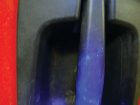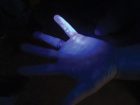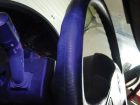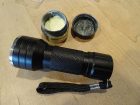
At our last practice, I tried to demonstrate the process of cross-contamination from bunker gear to equipment, individuals, the fire hall, personal vehicles, and even to personal vehicles. The latter would eventually lead to contaminants being brought into the homes of our members.
There are several excellent videos that demonstrate this point. However, I felt it important for our members to actually experience this for themselves. I wanted the “shock value” of this self-discovery.
We did not really get into the decontamination processes after a fire, but we did mention showering, routine cleaning of gear, bagging gear before transport, and using wipes on scene. These things are addressed in the Invisible Danger and New Badge of Honor videos on YouTube. Be sure to watch the version which includes Bunker Gear Transfer.
It is well-documented that firefighters are at increased risk of developing certain cancers, including respiratory, urinary/reproductive system and malignant mesothelioma.
In 2010, researchers from the National Institute for Occupational Safety and Health (NIOSH) launched a multi-year study to examine whether firefighters have a higher risk of cancer and other causes of death due to job exposures. It was estimated that firefighter lifetime cancer risk is about 14 per cent greater than the general public. The chances of getting lung cancer and leukemia were seen to increase with fire runs and amount of time at fires.
This column will hopefully show you a simple but powerful way to prepare your members to readily receive this information, resulting in a change of attitude regarding contamination transfer.
The cost to your training budget will be around $60 – a bargain to be sure if even just one member discovers how easy it is to spread contaminates we pick up at calls.
I ordered a UV Theft Detection Powder and UV LED Flashlight combo kit online and received it within a week. With shipping it worked out to $56.42 (Cdn.)
This powder glows bright blue only under UV black light and is invisible. The trick is to lightly dust with the powder, making it impossible to see. (I used a bit too much at first)
Last practice, I set up a room-search scenario. I used three small traffic cones as “bodies.” With a permanent marker, I added a number (one to three) to each one. Then, using a make-up brush I covered each with a light dusting of the powder and hid the cones in various places in our two-level fire hall.
Once the members donned their bunker gear they were divided into two teams (to promote competition). Each team was assigned an IC, and they chose members to be in SCBA (breathing air). Let me say, we never, ever just go in with a mixed team of BA-wearing and non-BA-wearing members, however, we did make an exception in this case. Not sure about your department dynamics, but we have members who will never go into a building wearing BA (due to age or health), but I wanted everyone to experience this contamination transfer.
I wrote the numbers, one to three, on pieces of paper and had each IC choose one. Each team was to retrieve only the cone with their assigned number printed on it. Both teams went in one after the other and, in our case, one team went up the stairs to the second level. The others did a left-hand search.
Again, this really wasn’t about the “room search,” however we had them follow our department’s SOGs. When a cone was discovered it was passed from one team member to another. Once the cone was safely in the hands of the last member, they notified the IC, who told them to exit the building.
When both teams retrieved their cones, we debriefed the “room searches” and engaged in a question-and-answer period. The members still had no idea about the real reason behind this practice. I did this so that they would not behave any different before, during, or after this call simulation.
The practice, as far as they were concerned, was over so they doffed their gear and brought apparatus back in. When we were “supposedly” all cleaned up and ready to go home I called for everyone’s attention. I informed them that this practice was in fact about “contamination transfer.” I explained how the invisible powder was placed on the three cones.
Then, we turned off the lights in the hall and my assistant trainer and I, each armed with UV flashlights, began to shine on the gear hanging up in the lockers. There were audible exclamations of surprise as gloves, helmets and bunker gear glowed blue. When we retraced some of the search patterns, we discovered powder on the key pad for the hall door, the training room door knob and on various objects in the hall.
It was even more of an eye-opener when the UV lights lit up the powder on Engine One’s steering wheel, door handles and BA packs. Then, one member gasped as they discovered powder on their hands.
We had their attention to be sure. This brought out a verbal commitment from all our members to become vigilant in the decontamination process.
We talked about the danger of bringing gear home, or even keeping gear in bags in member’s personal vehicles. Our department immediately instituted new rules regarding gear in the training room.
They are also ordering first responder coveralls that will be kept in individual bags in the medical room. No more wearing of bunker gear or multi-purpose coveralls to first-response medical calls. Our gear was clean, but after this practice we were not taking any chances.
This was an eye-opening practice. I am sure there will be many changes, good changes to our SOGs regarding contaminated gear. It’s time we begin to save lives, starting at the fire hall.
Stay safe and remember to train like lives depend on it, because they do.
Ed Brouwer is the chief instructor for Canwest Fire in Osoyoos, B.C., deputy chief training officer for Greenwood Fire and Rescue, a fire warden, wildland urban interface fire-suppression instructor and ordained disaster-response chaplain. Contact Ed at aka-opa@hotmail.com.
Print this page



